Menus
- Discovery
- In the saddle
- Contact
- In the city
- Highway
- Departmental
- Comfort and duo
- Braking
- Consumption
- Convenient
- Conclusion
The XJ6 is the great innovation of Yamaha 2009: the return of the legendary beginner’s motorcycle in terms of name but a new motorcycle in its own right in terms of look, engine, frame … in tubular steel with 6.1 mkg of torque at only 8,500 rpm. Only the maximum power of 78 horsepower makes it instantly lean into the easy category…. On paper. And in real life ?

Discovery
The styling of the XJ6 has its roots and its imprint on the FZ6 Fazer. It is even difficult to differentiate them from a distance: same general shape, similar headlight. The XJ6 is based on the same liquid-cooled, four-cylinder, four-stroke, four-valve, dual overhead camshaft, but with specific cylinder head, camshafts, intake, exhaust and clutch. Even up close, the speedometer and saddle look similar. The hexagonal headlight on the other hand is the most beautiful effect and very much in tune with the times.
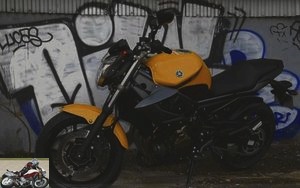
You could suddenly think that only the 20 fewer horses and a lower torque differentiate them. But while the trail and caster angle are the same between the two models, the two bikes have different frames. The XJ6 is satisfied with a steel frame of the "Diamond" type with a saddle and a seat clearance 5mm lower than the FZ6, but also with a tank of only 17.3 liters compared to the 19.4 liters of the FZ6. After the exhausts under the saddle, we appreciate here the pot almost entirely hidden under the engine and partly the swingarm.
The finish is there at all levels while one would have thought that the steel frame, compared to the aluminum frames of the competition, foreshadowed some savings. It is not so. The realization is beautifully made and the details meticulous.
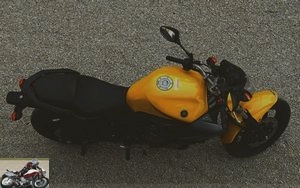
The whole thing is a short, stocky (small wheelbase of 1440 mm) and almost aggressive roadster. In fact, it doesn’t give the impression of being a beginner’s bike in any way..
In the saddle
The feet touch the ground for the 1.70m rider with a saddle at the standard height for the 785mm category. The saddle height is similar to that of an ER6 and should therefore facilitate access for women.
The legs fit nicely and easily around the tank. The position is slightly advanced, resting on the handlebars. Everything is natural.
Despite its 211 kilos fully packed (216 for the ABS version), the Diversion seems light, much lighter than its ancestor, but not as much as an ER6.
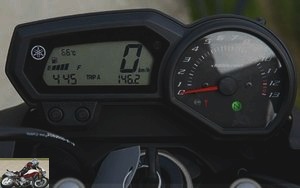
The classic Yamaha dashboard reveals a digital speedometer on the left, with clock display, fuel gauge and partial trip and an analog tachometer on the right with a high red zone at only 11.5000 rpm! (14,000 rpm for the FZ6).
Contact
The XJ6 snorts in a quiet sound. First engaged, the engine goes up in the towers without that not particularly felt on the handlebars. Everything is immediately very soft, with an obvious suppleness…. so much so that the XJ6 accepts idling at 1,100 rpm in sixth without complaining !
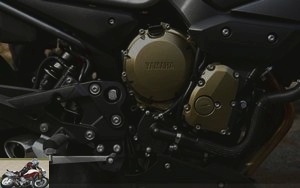
The well-placed mirrors offer very good visibility and do not vibrate in any way, whatever the speed.
In the city
The XJ6 takes everything from the first climb up to the 80 km / h red zone (even 90 km / h but not in town) to the sixth rolled up at 1,100 rpm at 25 km / h. She even agrees to start at a red light in second! Conversely, it is almost brutal in town on the 2nd and 3rd, especially when decelerating. Suddenly, for quiet use, we rather go up the gears to prefer the 4th.
The only detail to note is the vibrations in the brake pedal. But who keeps their foot on the brake pedal all the time? In any case, for bikers doing a lot of town, this is a good way to break this bad habit..
The handling is at the rendezvous and the XJ6 slips everywhere, without difficulty. 4.75 turning radius helps navigate well and simply make U-turns in small lanes.
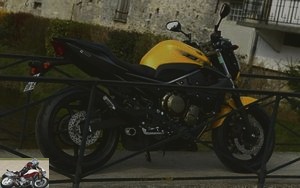
Highway
Leaving Paris came about naturally. At 110 km / h and 6,000 rpm, it is just at speed where it takes its turns easily to climb easily, even vigorously 17 km / h for every additional 1,000 rpm. In fact, the pressure on the neck is barely felt above 150 km / h, cruising speed at which it could almost settle comfortably and without surprise. The XJ6 still only turns at 8,000 rpm and accepts without problem taking another 2,000 rpm without problem. The course is impeccable despite the wind.
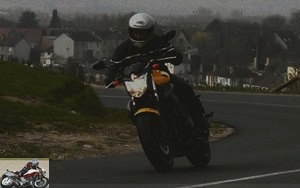
Departmental
The XJ6 can roll obediently on small roads but above all willingly accepts to climb into towers, including in the red zone! She approaches the bends with disconcerting ease. A light pressure on the handlebars is enough to place it and it would even tend to accentuate the thrust to literally help the rider to enter and exit the turn just as quickly. It impresses with its behavior and the rigidity of the frame on the angle without side reactions. Riding in Diablo Rosso helps to have a good grip. In this game, she instantly builds confidence and accepts a more sustained pace..
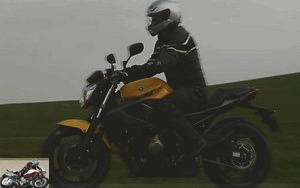
For those who want to work hard, the 3rd offers the best compromise accepting nervously resuming 5,000 rpm and accepting to stay in the red zone up to 150 km / h. But those who just want to take a little leisurely stroll can stay in 6th, including passing through villages where the XJ6 agrees to wind at 25 km / h to quietly resume up to 4,000 rpm at the exit, before taking turns around 5500 rpm and take off from 6,500 rpm and up to 9,000 rpm. Then if the bike enters the red zone without worry and does not really break until the end of the red zone at around 12,500 rpm, it is no longer useful. The real sensations are rather between 6,000 and 9,000 rpm even if the useful range is much wider. The XJ6 is therefore appreciated lower in the towers than an FZ6 and that’s good on a daily basis..
Comfort and duo
The saddle is comfortable. The passenger position is well thought out with a high saddle (good vision), rather low footrests and a comfortable saddle. The well-designed handles suggested a good grip, especially with a hollow shape on the inside. But in use, they do not allow a good grip and above all do not allow you to hold on well if the pilot starts to have a little sporty driving, which the XJ6 allows.

Braking
The rear brake with its single 245 mm disc gives an impression of…. spongy. The pedal seems to be sinking into slack and its effectiveness is limited. At least the beginner is not likely to block it. The front brake double disc of 298 mm, on the other hand, surprises with its bite, limit aggressive, even making the bike dive quite easily. It therefore takes a bit of skill and practice before appreciating its effectiveness..
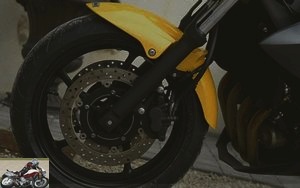
Consumption
The first of the 5 sticks falls after 45 km and each subsequent stick falls after about 50 km depending on the type of riding. The reserve tends to engage after 250 km, an incremental counter then indicating the number of kilometers traveled since the reserve. In mixed driving, consumption fluctuates between 4.8 and 5.2 liters per hundred but can exceed 6 liters in sportier driving (with identical driving, the ER6 consumes 1 liter less). With its 17.3-liter tank, the XJ6 Diversion therefore allows a maximum range of 300 km..
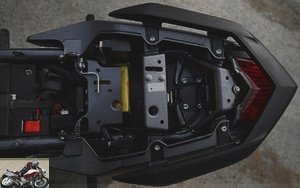
Convenient
There is a space provided for placing a long U lock…. but the bridge in width prevents its angle from slipping it or else requires a short U. Abuse should come out in May 2009.
We appreciate the central stand, but only optional (included on the faired version on the other hand).
We regret the lack of rigging points at the rear; it is still possible to attach to the footrests.
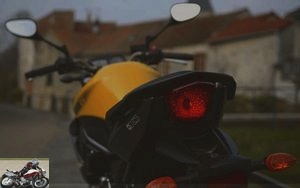
Conclusion
Yamaha has once again made a success of its roadster, while making its novelty benefit from the sympathy of the basic motorcycle of the year 1992. More affordable in terms of behavior than an FZ6, it confirms its position as an ideal motorcycle for beginners, with an engine that really accepts all speeds without complaining, from 1,100 rpm to 12,000 rpm. It thus undoubtedly offers one of the widest usable ranges. Homogeneous, versatile, she is already a good all-rounder. At 6,349 euros (6,749 euros in ABS version and in faired version and 7,149 euros faired with ABS), it is just a bit more expensive than the Bandit 650 and the CBF 600 (5,990 €).
Strong points
- ease of use
- pleasant engine, smooth and able to fly
Weak points
- practical aspects
- duo
Competitors: Honda Hornet, Kawasaki ER6n, Suzuki Bandit 650, Suzuki Gladius
The XJ6 technical sheet
Related articles
-
Triumph Tiger 1050 motorcycle test
A 4-day trial over 1,100 km The Triumph Tiger had taken a sacred look of old over the years, especially compared to the new Varadero and VStrom, despite…
-
Triumph Daytona 675 motorcycle test
After several sports trials 4 cylinders in 600 cm3 (TT 600 then Daytona 600), Triumph gives up to reveal finally a sports 600 based on a 3 cylinder: the…
-
Biker test: R-One All the world dreams of one day finding THE motorcycle. The one who changes life in the absence of the world, which retraces the roads,…
-
Comparative motorcycle test Kawasaki Ninja 650 A2 and full
Daily trial for 15 days of both versions 649 cc, 68 hp – 47.5 hp in A2 – for 193 kilos Who remembers the ER-6, the model unveiled in 2005 and since…
-
Honda CBF 1000 ABS motorcycle test
The Honda CBF 1000 is the big sister of the CBF 600, which appeared in 2006. Apart from a slightly larger size, the two models are aesthetically very…
-
Kawasaki Versys 650 motorcycle test
Twin-cylinder 649 cc, 69 hp, 210 kilos, A2 version, euro5 ready Daily test 2006, the year of the successive revivals of Kawasaki on segments where we…
-
Honda Transalp 700 XLV motorcycle test
10 day trial The Transalp is the legendary Honda 600 trail created in 1987. After several years without major modification except a displacement…
-
Honda CB 1300 S motorcycle test
The CB 1300 is the big Honda roadster in the line of the Bandit 1200 and XJR 1300. Introduced in 2003 in the spirit of the Big One, the CB 1300 belongs…
-
Kawasaki Z 750 motorcycle test
Cure of youth After a big success and more than 62,000 models sold, the Kawasaki Z750 evolves only 3 years later its output: engine, chassis and design….
-
Suzuki Gladius 650 SFV motorcycle test
The Gladius is the new Suzuki 2009, directly from the SV: a V-Twin 90 ° 72 horsepower come to give a boost to the bi family and compete with the famous…